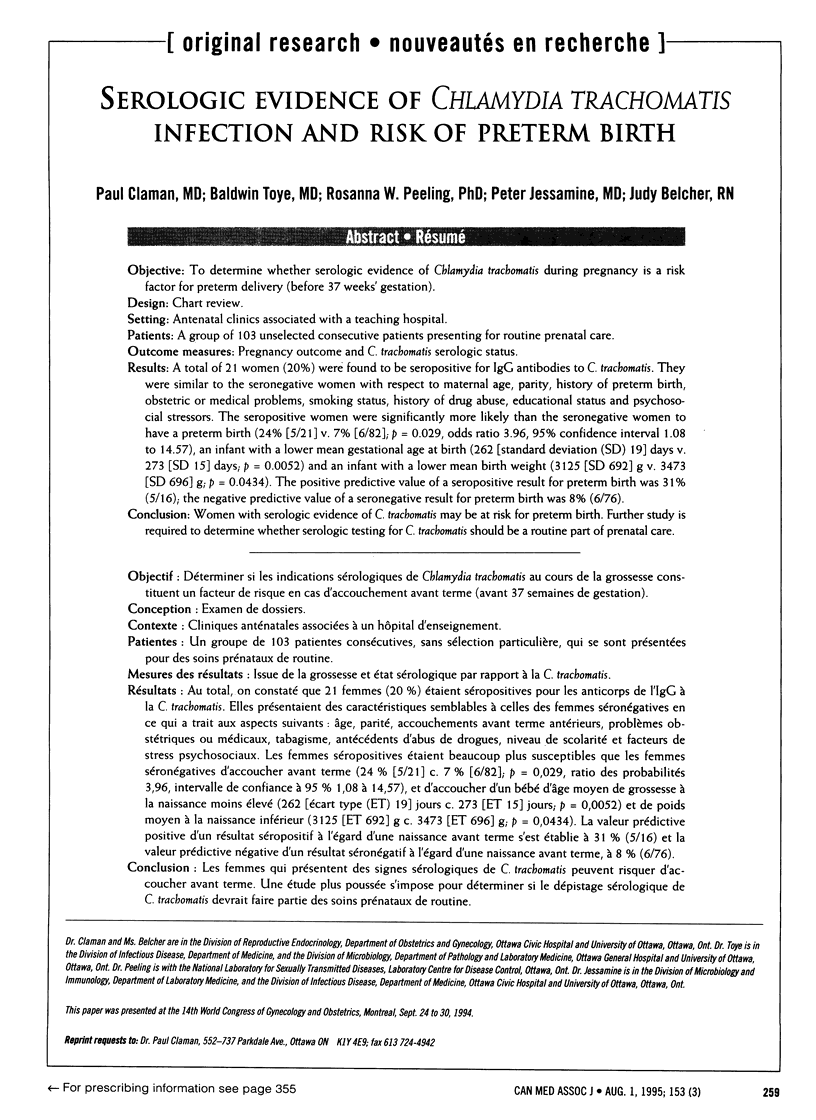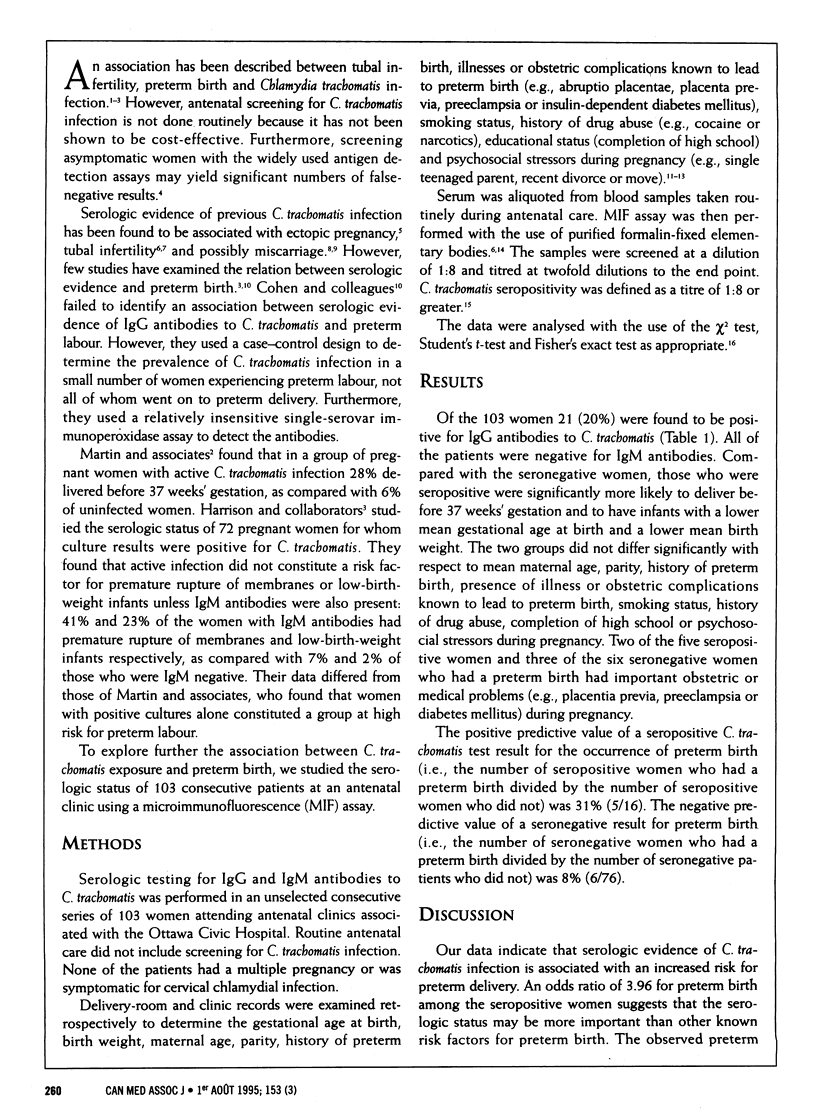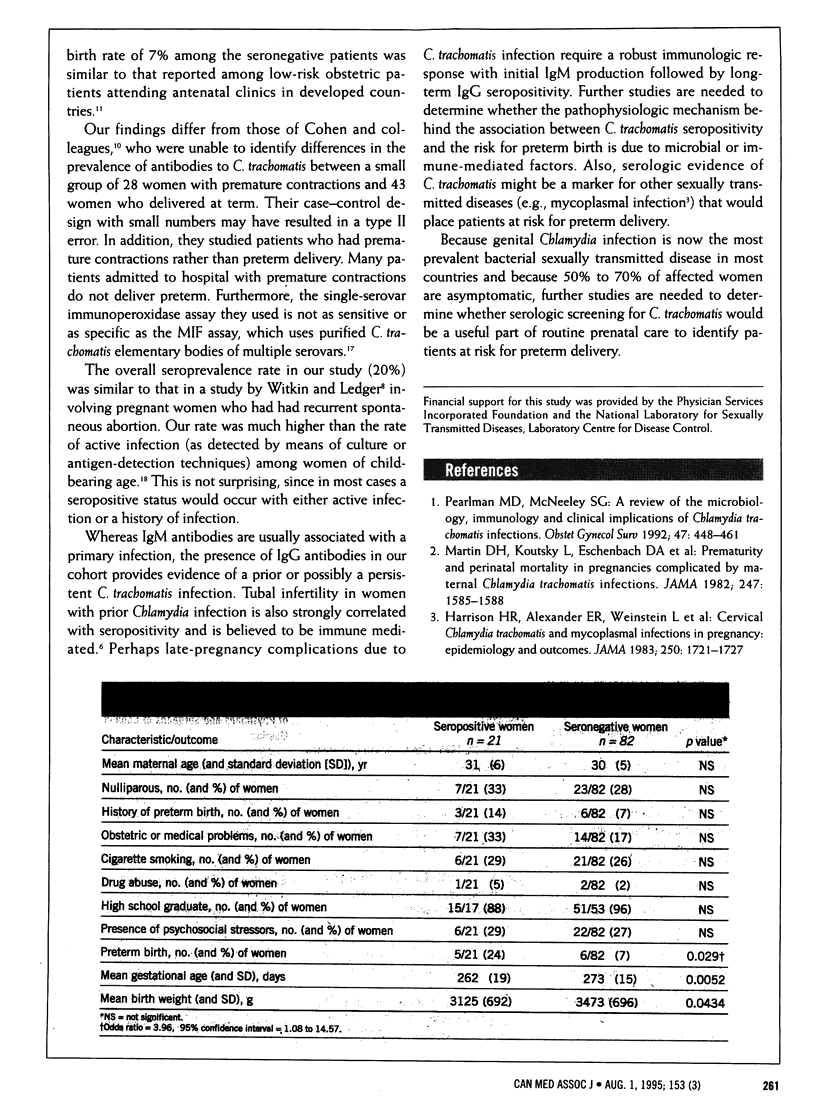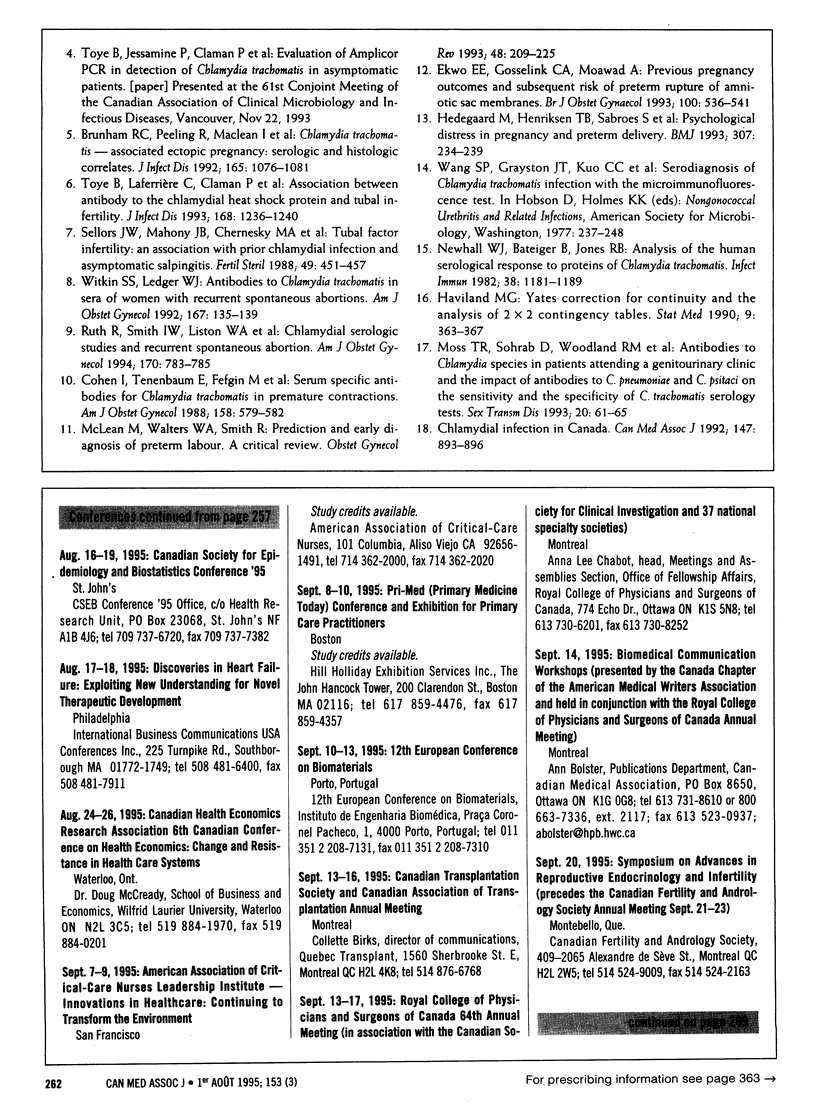Abstract
OBJECTIVE: To determine whether serologic evidence of Chlamydia trachomatis during pregnancy is a risk factor for preterm delivery (before 37 weeks' gestation). DESIGN: Chart review. SETTING: Antenatal clinics associated with a teaching hospital. PATIENTS: A group of 103 unselected consecutive patients presenting for routine prenatal care. OUTCOME MEASURES: Pregnancy outcome and C. trachomatis serologic status. RESULTS: A total of 21 women (20%) were found to be seropositive for IgG antibodies to C. trachomatis. They were similar to the seronegative women with respect to maternal age, parity, history of preterm birth, obstetric or medical problems, smoking status, history of drug abuse, educational status and psychosocial stressors. The seropositive women were significantly more likely than the seronegative women to have a preterm birth (24% [5/21] v. 7% [6/82]i p = 0.029, odds ratio 3.96, 95% confidence interval 1.08 to 14.57), an infant with a lower mean gestational age at birth (262 [standard deviation (SD) 19] days v. 273 [SD 15] days; p = 0.0052) and an infant with a lower mean birth weight (3125 [SD 692] g v. 3473 [SD 696] g; p = 0.0434). The positive predictive value of a seropositive result for preterm birth was 31% (5/16); the negative predictive value of a seronegative result for preterm birth was 8% (6/76). CONCLUSION: Women with serologic evidence of C. trachomatis may be at risk for preterm birth. Further study is required to determine whether serologic testing for C. trachomatis should be a routine part of prenatal care.
Full text
PDF



Selected References
These references are in PubMed. This may not be the complete list of references from this article.
- Brunham R. C., Peeling R., Maclean I., Kosseim M. L., Paraskevas M. Chlamydia trachomatis-associated ectopic pregnancy: serologic and histologic correlates. J Infect Dis. 1992 Jun;165(6):1076–1081. doi: 10.1093/infdis/165.6.1076. [DOI] [PubMed] [Google Scholar]
- Cohen I., Tenenbaum E., Fejgin M., Altaras M., Ben-Aderet N., Sarov I. Serum-specific antibodies for Chlamydia trachomatis in premature contractions. Am J Obstet Gynecol. 1988 Mar;158(3 Pt 1):579–582. doi: 10.1016/0002-9378(88)90031-2. [DOI] [PubMed] [Google Scholar]
- Ekwo E. E., Gosselink C. A., Moawad A. Previous pregnancy outcomes and subsequent risk of preterm rupture of amniotic sac membranes. Br J Obstet Gynaecol. 1993 Jun;100(6):536–541. doi: 10.1111/j.1471-0528.1993.tb15304.x. [DOI] [PubMed] [Google Scholar]
- Harrison H. R., Alexander E. R., Weinstein L., Lewis M., Nash M., Sim D. A. Cervical Chlamydia trachomatis and mycoplasmal infections in pregnancy. Epidemiology and outcomes. JAMA. 1983 Oct 7;250(13):1721–1727. [PubMed] [Google Scholar]
- Haviland M. G. Yates's correction for continuity and the analysis of 2 x 2 contingency tables. Stat Med. 1990 Apr;9(4):363–383. doi: 10.1002/sim.4780090403. [DOI] [PubMed] [Google Scholar]
- Hedegaard M., Henriksen T. B., Sabroe S., Secher N. J. Psychological distress in pregnancy and preterm delivery. BMJ. 1993 Jul 24;307(6898):234–239. doi: 10.1136/bmj.307.6898.234. [DOI] [PMC free article] [PubMed] [Google Scholar]
- KNOX E. G., COURT S. D., GARDNER P. S. Aetiology of intussusception in children. Br Med J. 1962 Sep 15;2(5306):692–697. doi: 10.1136/bmj.2.5306.692. [DOI] [PMC free article] [PubMed] [Google Scholar]
- Martin D. H., Koutsky L., Eschenbach D. A., Daling J. R., Alexander E. R., Benedetti J. K., Holmes K. K. Prematurity and perinatal mortality in pregnancies complicated by maternal Chlamydia trachomatis infections. JAMA. 1982 Mar 19;247(11):1585–1588. [PubMed] [Google Scholar]
- McLean M., Walters W. A., Smith R. Prediction and early diagnosis of preterm labor: a critical review. Obstet Gynecol Surv. 1993 Apr;48(4):209–225. doi: 10.1097/00006254-199304000-00001. [DOI] [PubMed] [Google Scholar]
- Moss T. R., Darougar S., Woodland R. M., Nathan M., Dines R. J., Cathrine V. Antibodies to Chlamydia species in patients attending a genitourinary clinic and the impact of antibodies to C. pneumoniae and C. psittaci on the sensitivity and the specificity of C. trachomatis serology tests. Sex Transm Dis. 1993 Mar-Apr;20(2):61–65. doi: 10.1097/00007435-199303000-00001. [DOI] [PubMed] [Google Scholar]
- Newhall W. J., Batteiger B., Jones R. B. Analysis of the human serological response to proteins of Chlamydia trachomatis. Infect Immun. 1982 Dec;38(3):1181–1189. doi: 10.1128/iai.38.3.1181-1189.1982. [DOI] [PMC free article] [PubMed] [Google Scholar]
- Pearlman M. D., McNeeley S. G. A review of the microbiology, immunology, and clinical implications of Chlamydia trachomatis infections. Obstet Gynecol Surv. 1992 Jul;47(7):448–461. doi: 10.1097/00006254-199207000-00002. [DOI] [PubMed] [Google Scholar]
- Rae R., Smith I. W., Liston W. A., Kilpatrick D. C. Chlamydial serologic studies and recurrent spontaneous abortion. Am J Obstet Gynecol. 1994 Mar;170(3):782–785. doi: 10.1016/s0002-9378(94)70282-9. [DOI] [PubMed] [Google Scholar]
- Sellors J. W., Mahony J. B., Chernesky M. A., Rath D. J. Tubal factor infertility: an association with prior chlamydial infection and asymptomatic salpingitis. Fertil Steril. 1988 Mar;49(3):451–457. doi: 10.1016/s0015-0282(16)59772-6. [DOI] [PubMed] [Google Scholar]
- Toye B., Laferrière C., Claman P., Jessamine P., Peeling R. Association between antibody to the chlamydial heat-shock protein and tubal infertility. J Infect Dis. 1993 Nov;168(5):1236–1240. doi: 10.1093/infdis/168.5.1236. [DOI] [PubMed] [Google Scholar]
- Witkin S. S., Ledger W. J. Antibodies to Chlamydia trachomatis in sera of women with recurrent spontaneous abortions. Am J Obstet Gynecol. 1992 Jul;167(1):135–139. doi: 10.1016/s0002-9378(11)91647-0. [DOI] [PubMed] [Google Scholar]


